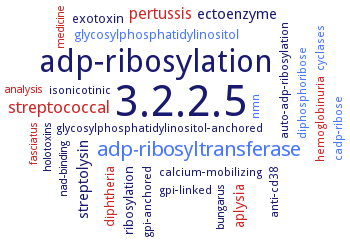Please wait a moment until all data is loaded. This message will disappear when all data is loaded.
Please wait a moment until the data is sorted. This message will disappear when the data is sorted.
2'-deoxy-2'-fluoroarabinoside adenine dinucleotide
-
-
2-Hydroxy-3,5-diiodo-benzoic acid
-
-
2-Hydroxy-5-iodo-benzoic acid
-
-
4-Carboxyhydrazide-pyridine-adenine dinucleotide
-
-
8-azidoadenosyl-carba-NAD+
-
-
8-azidoadenosyl-pseudocarba-NAD+
-
-
adenosine 3',5'-monophosphate
ADP-(2-deoxy-2-fluoro-D-arabinose)
the NAD analogue forms a covalent adduct after nicotinamide cleavage, resulting in inhibition of the enzyme activity, binding structure, overview
ADP-(2-deoxy-2-fluoro-D-ribose)
the NAD analogue forms a covalent adduct after nicotinamide cleavage, resulting in inhibition of the enzyme activity, binding structure, overview
ADP-ribosylated protein
-
-
-
Alpha-NAD+
-
5 mM, 70% inhibition
b-series gangliosides
-
-
-
beta-NAD+
-
substrate inhibition, mediated by ADP-ribosylation, partially reversible by arginine or histidine, inhibits apoptosis in vivo
Cu2+
-
the enzyme has two classes of Cu2+ binding sites, one activator site with high affinity and approximately six inhibitor sites with low affinity
deamino-NAD+
-
5 mM, almost complete inhibition
dioxane
-
more than 0.05 mM inhibit the activity
dithiothreitol
-
inhibits both NADase and ADPase activities through the reduction of Cu(II) to Cu(I) and the cleavage of disulfide-bonds in AA-NADase
GD1a
-
exogenous ganglioside, slight inhibition, inhibition in vivo
GD1b
-
exogenous ganglioside, inhibition in vivo
GD3
-
exogenous ganglioside, inhibition in vivo
glutathione
-
inhibits both NADase and ADPase activities through the reduction of Cu(II) to Cu(I) and the cleavage of disulfide-bonds in AA-NADase
GM1b
-
exogenous ganglioside, slight inhibition, inhibition in vivo
GT1b
-
exogenous ganglioside, inhibition in vivo, needs to be incorporated into the cell to inhibit CD38, preferably cis interaction, i.e. CD38 and GT1b are located on the same cell, the tandem sialic acid residues linked to the internal galactose of the gangliotetraose core are crucial to the inhibition
hydroxylamine
inhibits the reaction between ADP-ribose and polypeptides
L-ascorbate
-
inhibits AA-NADase on both NADase and ADPase activities through the reduction of Cu(II) in AA-NADase to Cu(I)
m-aminophenylboronic acid
-
-
monoclonal antibody CS/2
-
inhibits the NAD+ glycohydolase activity of both the isolated extracellular domain of CD38 and cell-surface CD38, non-competitive. No effect on cyclase activity of enzyme
-
N1-cyclic inosine diphosphate ribose
-
NADP+
-
5 mM, almost complete inhibition
NMN
-
5 mM, 70% inhibition
Streptococcal NAD glycohydrolase inhibitor
the ifs gene, or SpyM3_0129, encodes an endogenous competitive inhibitor for the enzyme. IFS is localized intracellularly and forms a complex with the enzyme. This intracellular complex must be dissociated during export through the cell envelope. The interface between SPNct and IFS is highly rich in water molecules, binding structure, overview
-
streptococcal NADase inhibitor
-
161 amino acids, MW 18800 Da, thermostable. Monomeric NADase and the streptococcal NADase inhibitor rapidly form in vitro a stable heterodimer complex in the ratio 1.1, resulting in complete suppression of the hydrolase activity. The inhibitor protein, coexpressed and complexed with NADase, may protect the producer cocci from exhausion of NAD
-
tris(2-carboxyethyl)phosphine
-
TCEP, inhibits both NADase and ADPase activities through the reduction of Cu(II) to Cu(I) and the cleavage of disulfide-bonds in AA-NADase
3-acetylpyridine

-
-
adenosine 3',5'-monophosphate

-
-
adenosine 3',5'-monophosphate
-
not the soluble form
ADP

-
-
ADP-ribose

-
product inhibition
ADP-ribose
-
product inhibition
ADPribose

-
-
AMP

-
-
ATP

-
competitive
cyanidin

-
-
cyanidin
complete inhibition of the wild-type enzyme at 0.1 mM
DTT

-
-
EDTA

-
detergent solubilized NADase, not the steapsin treated enzyme
EDTA
-
irreversible inhibition
EDTA
-
inhibits the cyclase activity
isoniazid

-
-
NaCl

-
-
NaCl
-
0.5 M or more, 65% loss in activity, irreversible, DNA associated NADase
nicotinamide

-
-
nicotinamide
-
0.33 mM, 50% inhibition
nicotinamide
-
50 mM, 33% inhibition
nicotinic acid

-
-
nicotinic acid
-
slight inhibition, in vivo
protein IFS

-
an endogenous inhibitor, encoded by gene ifs
-
protein IFS
-
an endogenous NADase inhibitor, encoded by gene ifs, and localized in the cytoplasm. The NADase precursor exists as an inactive complex with IFS
-
pseudocarba-NAD+

-
-
thioNAD+

-
-
thioNAD+
-
5 mM, almost complete inhibition
Zn2+

-
stimulates the cyclase activity, inhibits the NAD glycohydrolase activity, zinc has a regulatory function at physiological concentrations of 0.6-4 mM, responsible for modulation of the ADP-ribose cyclase/NAD glycohydrolase activity ratio of the bifunctional enzyme in zinc-rich seminal plasma to 1:3 in situ, with the purified enzyme in absence of zinc the ratio is 1:110-120, in presence of Zn2+ it is 1:2-3, mechanism
Zn2+
-
about 80% inhibition at 1 mM
additional information

-
nicotinylhydroxamic acid derivates of NAD+
-
additional information
-
N1-alkylnicotinamide chlorides, n-alkylphosphates, aliphatic carboxylic acids, other pyridine bases other than nicotinamide, certain pyridine dinucleotides
-
additional information
-
N1-alkylnicotinamide chlorides, n-alkylphosphates, aliphatic carboxylic acids, other pyridine bases other than nicotinamide, certain pyridine dinucleotides
-
additional information
-
variety of pyridine bases, pyridine nucleotides
-
additional information
-
structure of the inhibiting gangliosides, overview
-
additional information
-
nuclear membrane NADase is insensitiv to 1 M NaCl
-
additional information
-
aliphatic amines and carboxylic acids are noncompetitive inhibitors
-
additional information
-
phosphatidylinositol-specific phospholipase C removes the GPI-anchored enzyme from the T-cell surface, not the non-GPI-anchored activity like with ART2- T-cells
-
additional information
-
not inhibited by rac-catechin, piceatannol, trans-resveratrol, praziquantel, cucurmin, chloroquine, mefloquine, Cibacron Blue 3GA, PJ-34, and 1,8-naphthalimide
-




 results (
results ( results (
results ( top
top






